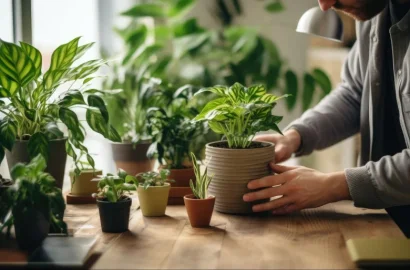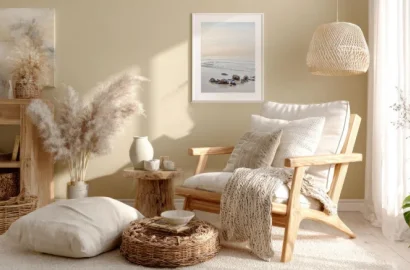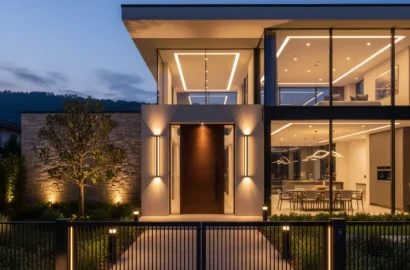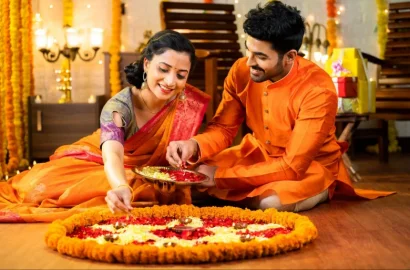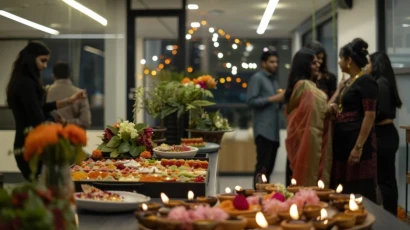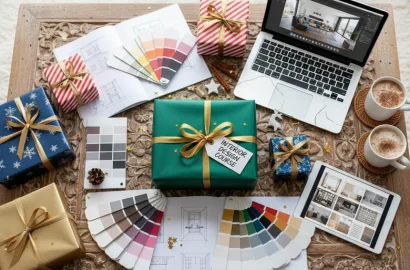Eclectic interior design is said to be the most aesthetic and habitable among contemporary designs. Read on to learn the why and the how of it all.
If you were to search ‘eclectic interior design’ on the internet, you would surely find pictures that would seem eclectic in the very simple dictionary meaning of the word, that is ‘unrelated, and unspecialized’. But, not for the reasons one might think at first. So then what are the reasons? And more importantly, what is eclectic interior design? Why is it most aesthetically appealing? And how can you bring this style into your own home?
In this article, we will answer all this and more. Come along as we explore everything about eclectic interior design from its origin and history to modern applications and trends.
Here’s a list of the topics that we have discussed in the article:
- What is Eclectic Interior Design?
- The History of Eclectic Design
- Essential Elements of Eclectic Design
- How to Achieve Eclectic Interior Design
- Tips & Common Mistakes to Avoid
- Why Choose Eclectic Interior Design?
- Current Trends in Eclectic Design
- Examples of Eclectic Interior Design
- Final Thoughts
- FAQs
What is Eclectic Interior Design?
The word ‘eclectic’ originates from the Greek eklektikos, which means ‘to select’. Eclectic interior design is fundamentally rooted in the act of curation—choosing and combining diverse elements to create personalized space. The philosophy behind eclectic design puts emphasis on variety and individuality that enables the expression of a multidimensional personal identity, interests, and experiences. Unlike other design styles that adhere to specific rules, eclectic design pivots on the freedom to mix and match, creating a narrative that reflects the inhabitant’s story.
In practice, eclectic interior design features mismatched colors, patterns, and furniture that may seem disproportionate at first glance. However, this intentional diversity serves a purpose –it symbolizes variety and personality. For instance, a room might include a vibrant rug from a trip abroad, a vintage bookshelf filled with personal mementos, and other pieces of modern art. Each element tells a part of the inhabitant’s story and the space becomes a reflection of their personality and journey. Ultimately, eclectic design is less about following conventions and more about individuality through thoughtful selection.
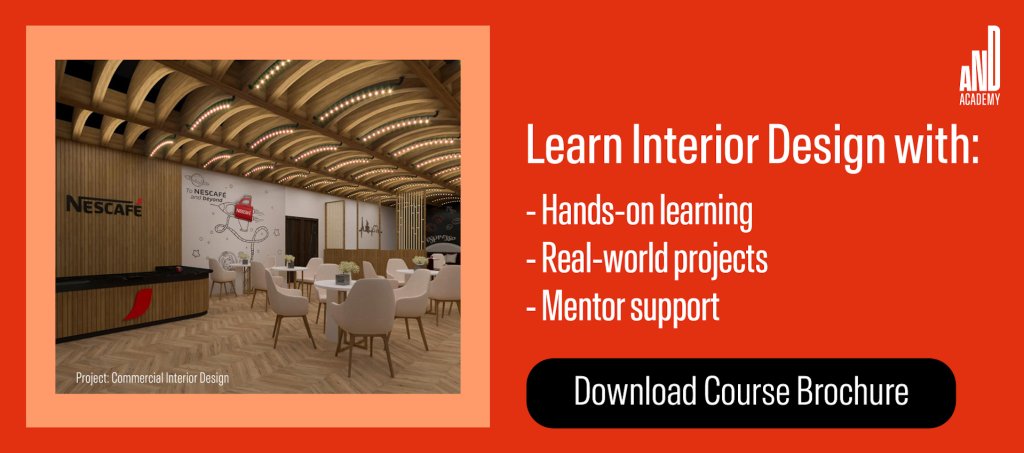
The History of Eclectic Design
In the 19th century, first the colonial empire and then, the Industrial Revolution made it possible to mass-produce furniture and decor which meant that materials and styles became more widely available to a growing middle class. Figures like Augustus Pugin, who designed the interiors of the Houses of Parliament (UK) by selecting and combining gothic elements and modern innovations, showed how different influences could be brought together to create something new.
The Arts and Crafts Movement of the late 19th century- which emerged as a response to industrialization and a rejection of mass production- led by figures like William Morris, celebrated handmade, artisanal goods and advocated for the beauty of imperfection and the value of human craftsmanship. It also introduced the idea that a home should be a reflection of the person living in it. This focus on personal expression over rigid design rules became a defining characteristic of eclectic interiors and gave furniture and decor a purpose beyond mere function.
The early 20th century saw movements like Art Nouveau, Art Deco, and Modernism. Art Nouveau’s flowing lines and natural motifs broke away from the rigid forms of traditional design. Like, the Paris Metro entrances that mixed organic shapes and intricate patterns. Art Deco, which gained prominence in the 1920s, incorporated elements from African, Egyptian, and Asian art, and encouraged the use of cultural motifs. Modernism, with its emphasis on simplicity and functionality, was considered too austere, and so, people began adding historical elements to their interiors, leading to a further shift towards eclectic interiors.
Postmodernism, which emerged in the 1970s and 1980s, rejected the strict rules of Modernism, embracing eclecticism, irony, and historical references. By the late 20th century, eclectic design had become a recognized style in its own right, with designers and homeowners intentionally mixing elements from different periods, cultures, and styles to create spaces.
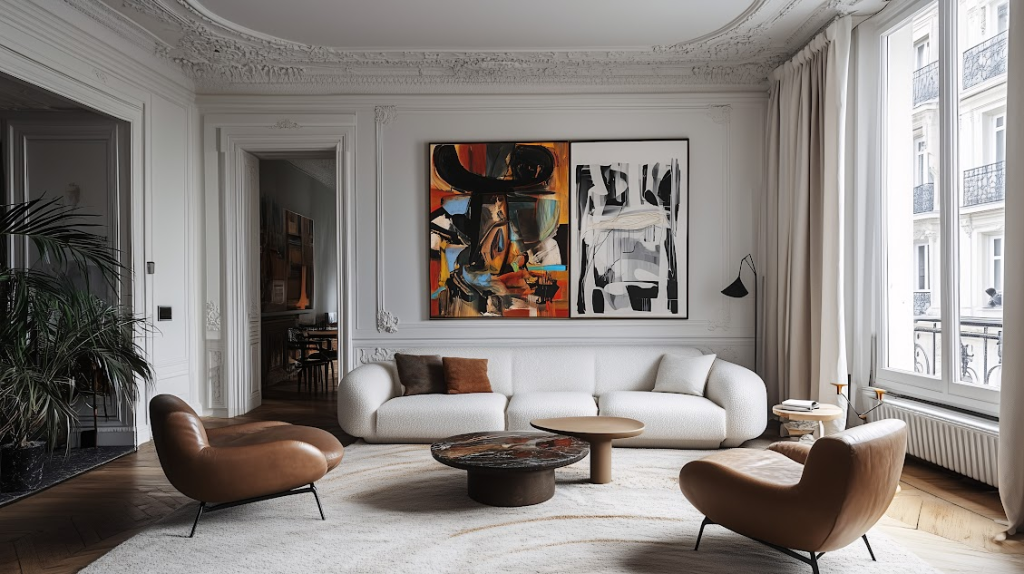
Essential Elements of Eclectic Design
Now that we know where eclectic design comes from and how it evolved over the years, let’s explore its elements in detail.
1. Bold Colors
Eclectic design mostly features bold, vibrant colors, and although there are no rules for choosing a color palette, there is a common pattern for using color intentionally so that the chaos looks manufactured. As long as there is an element in the foreground that matches another in the background, the design is cohesive. For example, a centerpiece matches the wall color.
Eclectic interior design style also features a multicolor theme in the space as compared to other contemporary designs which do not allow for a huge departure from a certain color palette.
2. Furniture From Different Eras
Furniture selection means mixing pieces from different eras and styles—a sleek modern chair next to a rustic wooden table, for instance, or a Victorian red velvet armchair put across a modern metal stool that has a red velvet cushion. In eclectic interiors, pieces share at least one common thread, whether it’s color, shape, or material even if they are completely different in other aspects –shape, origin, or proportion.
3. Texture as Variety
Texture in eclectic interior design functions for the variety aspect. A leather sofa might sit atop a shaggy wool rug, while a sleek glass coffee table contrasts with rough-hewn wooden shelving. Using multiple textures like plush, fur, velvet, metal, wood, etc works as vocabulary for telling the story.
4. Patterns that Differentiate
The pattern in eclectic design is its monopoly. Eclectic design incorporates multiple patterns in the same space, from geometric prints to floral motifs, and ethnic designs with contemporary graphics. The key to making this work is to vary the scale—placing a large-scale pattern in the background, such as bold wallpaper, while using a smaller, more intricate pattern in the foreground, like throw pillows or upholstery. Stripes, paisleys (called ‘buta’ in India), and abstract prints can all coexist in an eclectic setting as long as they are distributed with intention.
5. Accessories for Expression
Accessories in eclectic interior design are where the personality aspect comes in. They range from vintage trinkets and travel souvenirs to contemporary sculptures and statement lighting. Walls may have a collection of framed artworks and similar tapestries, while shelves display books, ceramics, and collectibles. The key is to fill up empty space without crossing the hoarder line.
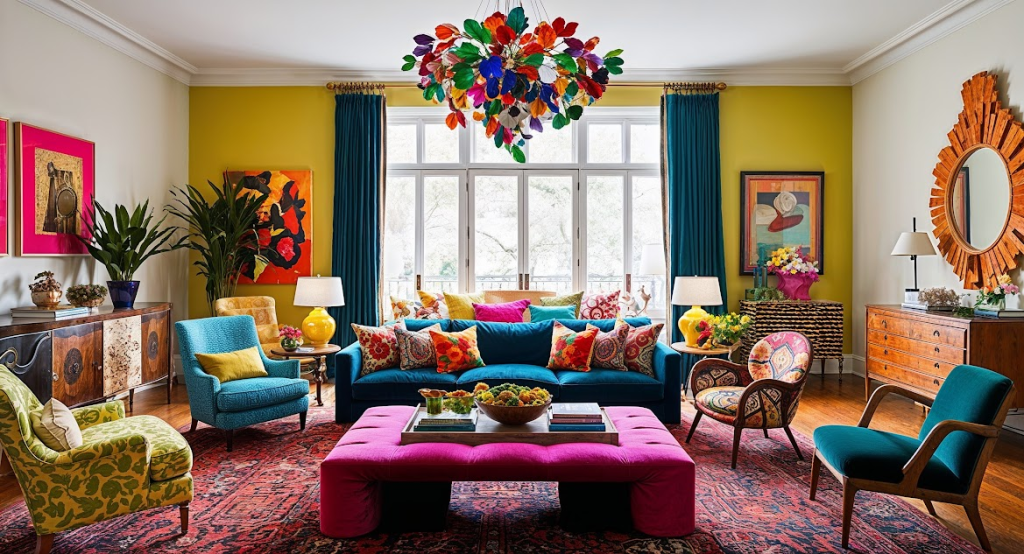
How to Achieve Eclectic Interior Design
Creating an eclectic space might seem like a challenge, but it’s easier than you think. The philosophy here is for each element in the room to have a meaning of its own and the overall design to tell a story of its own. As long as each element has one or two other complementing elements, it could be color, texture, or material, the design won’t break cohesion. Here’s a step-by-step guide to achieving eclectic interior design.
1. Know Your Story
Contemporary eclectic interior design is about storytelling in the most personal sense. That is how it has evolved over the years. Hence, it is important, before even thinking about the design and the look of the space, to settle on a story or a narrative for it. The story could be a reflection of who you are, or what you have achieved. The story could change depending on the various spaces in the house.
For instance, the living room design could tell a story about identity, the dining area could be about culture, the bathroom could be about travel, and so on. Thematicising spaces beforehand help in the selection of elements and color palettes making the process efficient and personal.
2. Choose a Base
Choose a base for your walls and larger furniture pieces. Since walls and large furniture pieces take up a significant amount of surface area and the field of vision, they serve as the foundation of your design. A neutral base, such as white, or grey provides room for flexibility. However, if your story calls for it, don’t hesitate to go bold; textured wallpapers or even mural-style wall art can make for an eclectic look.
A deep navy blue wall might feel cozy and dramatic, while an off-white backdrop could create an airy, gallery-like setting for vibrant furniture and decor. Whatever base you choose, make sure that it has one or more elements in the foreground complementing it.
3. Add Layers
Once you have a base, start layering different elements—furniture, rugs, artwork, and accessories. Layering is essential to achieving the overwhelming richness that defines eclectic design. This is where mixing and matching different textures, patterns, and styles comes into play.
Consider placing a vintage wooden coffee table over a modern geometric-styled rug or pairing a leather couch with a set of throw pillows. Experiment with a variety of materials such as metal, glass, velvet, and natural fibers to create visual and tactile variation. The layers should complement each other rather than compete for attention. Even when they do compete for attention, there should be a common thread between them.
4. Create Focal Points
The eclectic maximalist interior design boasts a focal point—something that immediately draws the eye and anchors the space. This could be a bold piece of artwork, a statement light fixture, or a colorful furniture piece. In eclectic design, focal points serve as visual anchors that bring some sort of cohesion to the mix of elements in a room. Without focal points, a space might feel scattered and overwhelming, especially in an eclectic space where every other element wants attention.
If the focal point is particularly bold—like a vibrant abstract painting or a sculpture—surrounding elements should complement rather than compete with it. There is no limit to the number of focal points a space can have within eclectic interior design; as long as the eye has resting spots.
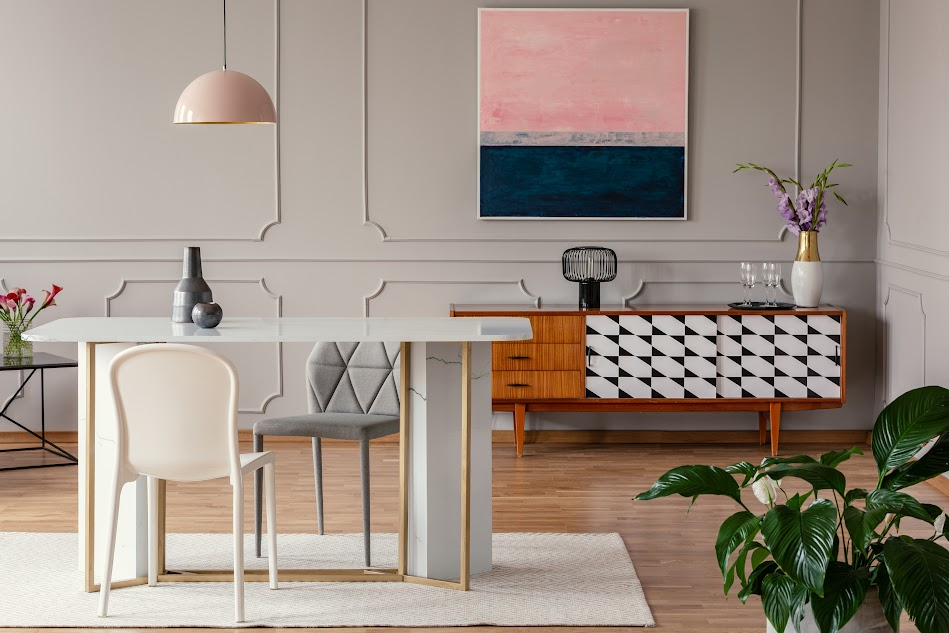
Tips for Mastering Eclectic Interior Design and Mistakes to Avoid
We have discussed how to achieve a fundamental eclectic interior design look. Here are some more tips to improve key areas and avoid common mistakes.
Make Small Adjustments
Pay attention to subtle details like balancing colors, adjusting furniture placement, or tweaking decor items to ensure everything feels curated rather than cluttered. A simple swap—like changing pillow covers to complement an artwork—can instantly create a more polished look.
Counter Chaos with Symmetry
One way to prevent visual chaos is by incorporating elements of symmetry. Placing a pair of similar chairs opposite each other or centering a bold statement piece can give the space a sense of balance. Symmetry helps ground the room and ensures that even with diverse elements, there’s a sense of order.
Be Mindful of Color Science
Understanding color relationships can help make thoughtful choices. Instead of using random hues, consider complementary colors that create harmony. For instance, if you have bold furniture, balance it with neutral walls, or if you love vibrant walls, use decor that picks up subtle shades from them.
Trust Your Instincts
Eclectic design is deeply personal, which means there are no strict rules. If a particular combination feels right to you, trust that instinct. Whether it’s an unconventional mix of furniture styles or an unexpected art placement, if it resonates with your personality and brings joy, it belongs in your space.
Watch out for Lack of Cohesion
An eclectic space should be varied, but it should not feel disjointed. A common thread—whether it’s a repeating color, texture, or material—can help tie the elements together. Without cohesion, the room can sometimes feel chaotic rather than thoughtfully designed.
Never Ignore Scale
A massive sofa next to a tiny coffee table might look awkward rather than artistic. Be mindful of how each piece relates in size to the others and to the room itself to maintain visual harmony.
Why Choose Eclectic Interior Design?
Eclectic design is for people who appreciate variety, creativity, and individuality in their living spaces. Unlike rigidly defined styles, eclectic interiors allow personal expression while maintaining an intentional and cohesive aesthetic.
Repurpose Existing Furniture
The eclectic style of interior design allows for the integration of new with the old, expensive with the affordable, and functional with the decorative. This flexibility makes it ideal for those who want to repurpose existing furniture while adding fresh, modern upgrades. It also supports multi-purpose spaces where a mix of styles can cater to different activities, whether it’s work, relaxation, or entertainment.
Storytelling Through Design
Eclectic interiors serve as a canvas for self-expression. Each piece in the space holds meaning—whether it’s a travel souvenir, an heirloom, or a modern statement piece. The mix of colors, textures, and patterns becomes a visual representation of personality, experiences, and interests.
Unlike other styles that require strict adherence to a specific look, eclectic design embraces imperfection and experimentation. It encourages creativity by allowing homeowners to mix and match elements that wouldn’t traditionally go together, adding character to the space.
Current Trends in Eclectic Design
Eclectic design is constantly evolving. Here are the top five latest trends:
1. Sustainability: A growing emphasis on sustainability has been influencing interior design for some time now and will continue to do so. Designers are integrating eco-friendly materials, reclaimed furniture, and energy-efficient fixtures into their eclectic schemes.
2. Calm Hues: More and more modern designs are departing from the corporate grey and white aesthetics and embracing warm beige, calm blues, and greens in their designs. Plum, ice blue, and other ‘royal’ colors are taking their place.
3. Color Drenching: No room for contrast skirts, borders, or ceilings. Pick a hero color or two and drench the room in it. This is becoming a common design choice in smaller spaces, especially when it comes to eclectic bedroom interior design.
4. Tartan: A classic check pattern usually seen on shirts, is making a comeback. It’s being featured in mockups and prototypes all around the world as a flooring pattern and as a fabric pattern list
5. Minimalism: Is on its way out, in favor of far more decorative and cozier spaces. In its place, elements of dopamine design, also known as Gen-Z design, are taking the lead when it comes to eclectic maximalist interior design choices.
Examples of Eclectic Interior Design
Let us look at some of the examples to better understand how the eclectic interior design philosophy is executed to achieve a specific look and tell a story.
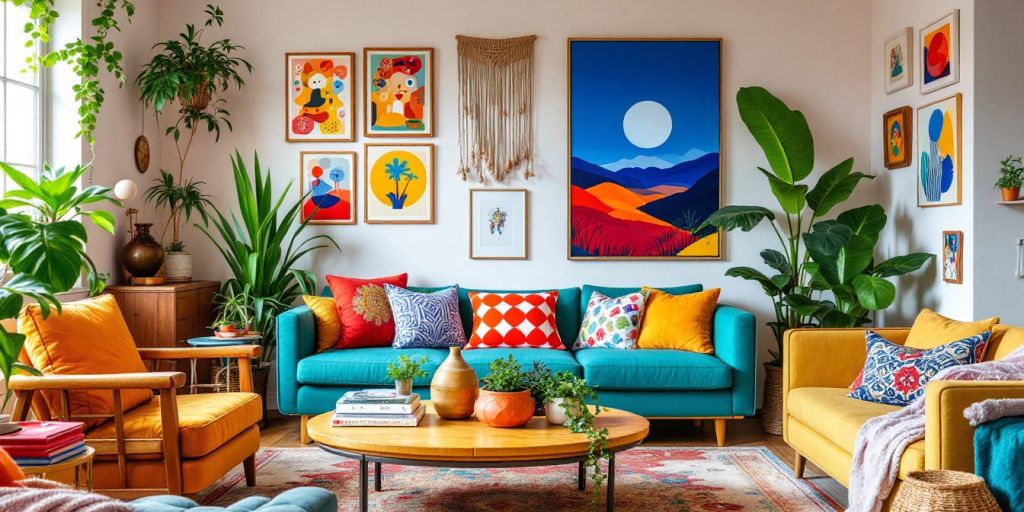
1. The above photograph shows a thoughtfully designed eclectic space. It has a base background of white that relies on color variety and patterns for the expression part. There is also variety in the types of furniture selection, and most importantly, there is the personality of the inhabitant that comes through as an overarching theme of this design – a disciplined artist.
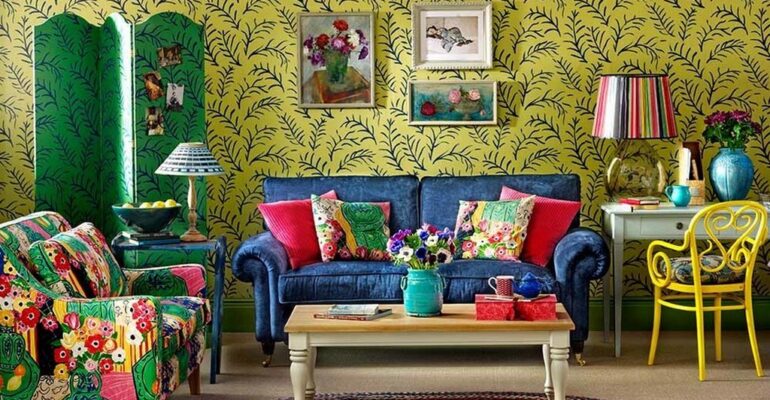
2. The above photograph is of a more mixed-style design, probably a traditional eclectic interior design. It has a base background of green that relies on color and pattern variety for the expression part. There is also variety in the types of texture choices, and, there is the personality of the inhabitant that comes through as a stark and intentional theme of this design – a systematized rebel.
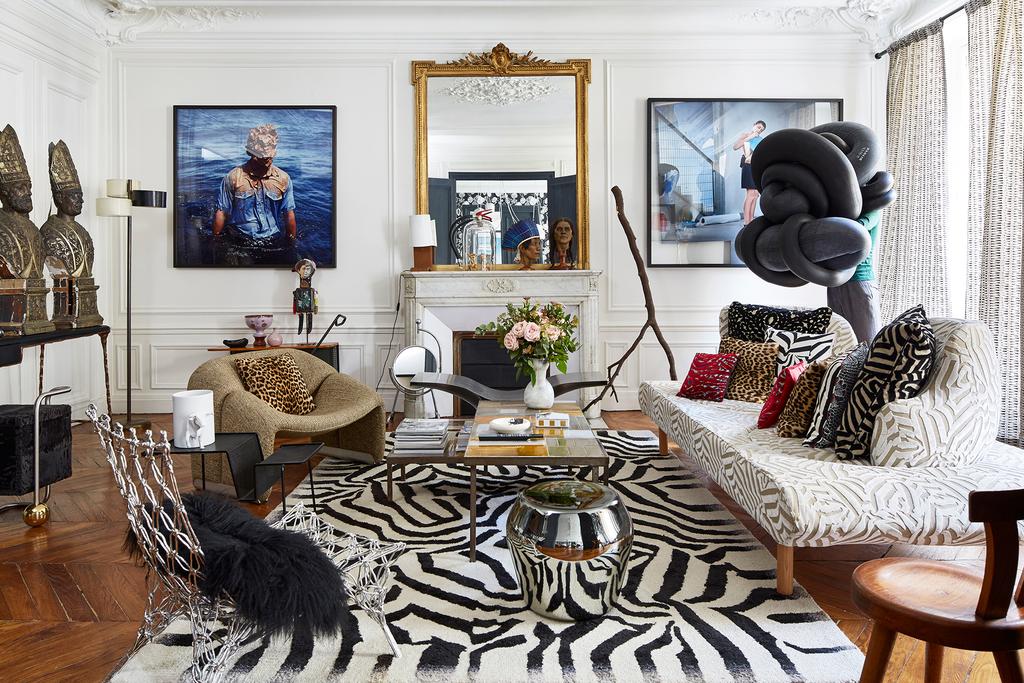
3. The above photograph shows another interior design eclectic living room aesthetic, that checks all the boxes of eclectic design. This design, compared to the other two, relies more heavily on object variety and patterns than colors, although it follows a complementing color scheme. There are objects from different eras, and finally, there is the personality of the inhabitant that comes through in this design – a dissatisfied indulger.
Final Thoughts
Eclectic interior design is more than just a mix-and-match aesthetic—it’s a message of individuality and personal storytelling. By combining different styles, eras, textures, and most importantly patterns, eclectic spaces break free from rigid design norms to create spaces full of character. The beauty of this style lies in its flexibility of expression; it allows homeowners to create a home that tells their story in the most personal manner.
We also recommend you check out this project by AND Learner, Aakriti Sharma to get inspiration for your next interior design project.
FAQs
Q. How do I choose a color palette for eclectic interior design?
- Start with a neutral base and add pops of color through furniture, decor, and textiles. Stick to a few key colors that take up a large surface area to maintain cohesion and add a multicolor effect through accessories.
Q. Can eclectic interior design work in small spaces?
- Absolutely. Just be mindful of scale and avoid overcrowding. Use multifunctional furniture.
Q. Is eclectic design expensive?
- Not necessarily. You can mix high-end pieces with thrift store finds and DIY projects to create a unique look on a budget.
Q. How do I avoid making my space look chaotic?
- Focus on the balance between spaces; placing objects at equal distances can reduce the chaos by increasing symmetry. Use a neutral base, and incorporate only one focal point to avoid clashing between focal points.
Q. Can I mix vintage pieces in modern eclectic interior design?
- Yes. Mixing modern and vintage is a hallmark of eclectic design. Just make sure that they have at least one common thread between them. It could even be a story of how you got them.
Next Steps
If you’d like to learn more about interior design, visit our blog, or consider the following resources:
- Watch this session by Snehanshu Mukherjee, Founding Partner at T.E.A.M, and Mansi Almadi, an Interior Designer at Studio Lotus
- Talk to a course advisor to discuss how you can transform your career with one of our courses.
- Check out our Interior Design courses – all courses are taught through live, interactive classes by industry experts.
- Take advantage of the scholarship and funding options that come with our courses to overcome any financial hurdle on the path of your career transformation.
Note: All information and/or data from external sources is believed to be accurate as of the date of publication.



